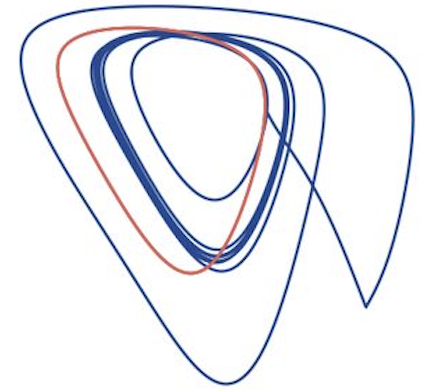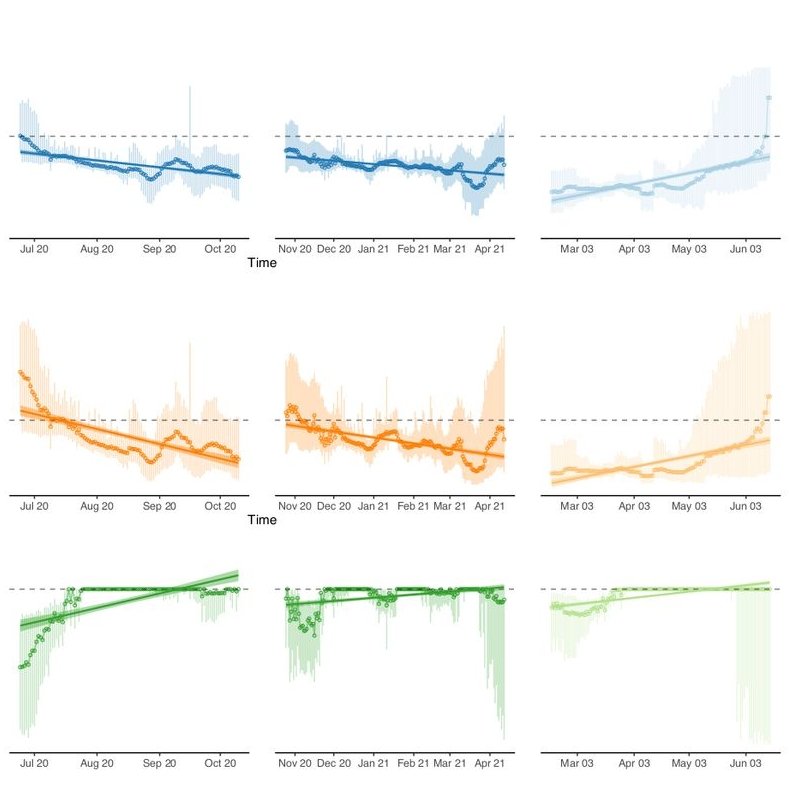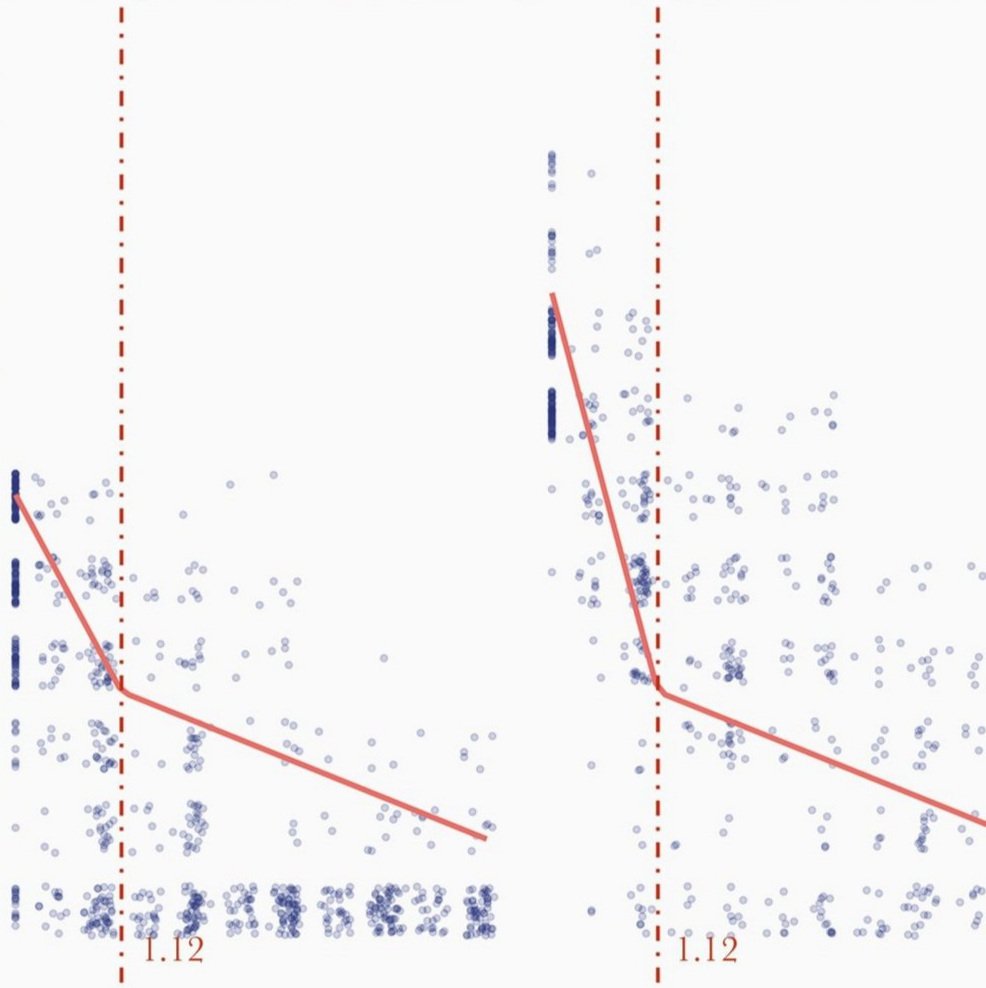Papers
Some recent computational modeling approaches used by CEIRR researchers are showcased in the papers below.
-

Near real-time data on the human neutralizing antibody landscape to influenza virus to inform vaccine-strain selection in September 2025 (2025)
Caroline Kikawa, John Huddleston et al.
The hemagglutinin of human influenza virus evolves rapidly to erode neutralizing antibody immunity. Twice per year, new vaccine strains are selected with the goal of providing maximum protection against the viruses that will be circulating when the vaccine is administered ∼8-12 months in the future. To help inform this selection, here we quantify how the antibodies
-

Susceptible host dynamics explain pathogen resilience to perturbations (2025)
Sang Woo Park, Bjarke Frost Nielsen et al.
Interventions to slow the spread of SARS-CoV-2 significantly disrupted the transmission of other pathogens. As interventions lifted, whether and when human pathogens would eventually return to their pre-pandemic dynamics remains to be answered. Here, we present a framework for estimating pathogen resilience
-

Phylo-rs: an extensible phylogenetic analysis library in rust (2025)
Sriram Vijendran, Tavis Anderson, Alexey Markin & Oliver Eulenstein
We introduce Phylo-rs: a fast, extensible, general-purpose library for phylogenetic analysis and inference written in the Rust programming language…
-

Development of avian influenza A(H5) virus datasets for Nextclade enables rapid and accurate clade assignment (2025)
Jordan T. Ort, Sonja A. Zolnoski et al.
The ongoing panzootic of highly pathogenic avian influenza (HPAI) A(H5) viruses is the largest in history, with unprecedented transmission to multiple mammalian species. Avian influenza A viruses of the H5 subtype circulate globally among birds and are classified into distinct clades based on their hemagglutinin (HA) genetic sequences. Thus, the ability to accurately and rapidly assign clades…
-

High-throughput neutralization measurements correlate strongly with evolutionary success of human influenza strains (2025)
Caroline Kikawa, Andrea N. Loes et al.
Human influenza viruses rapidly acquire mutations in their hemagglutinin (HA) protein that erode neutralization by antibodies from prior exposures. Here, we use a sequencing-based assay to measure neutralization titers…
-

Dimensionality reduction distills complex evolutionary relationships in seasonal influenza and SARS-CoV-2 (2024)
Sravani Nanduri , Allison Black et al.
Public health researchers and practitioners commonly infer phylogenies from viral genome sequences to understand transmission dynamics and identify clusters of genetically-related samples. However, viruses that reassort or recombine violate phylogenetic assumptions and require more sophisticated methods…
-

Spike deep mutational scanning helps predict success of SARS-CoV-2 clades (2024)
Bernadeta Dadonaite, Jack Brown et al.
SARS-CoV-2 variants acquire mutations in the spike protein that promote immune evasion and affect other properties that contribute to viral fitness, such as ACE2 receptor binding and cell entry.Knowledge of how mutations affect these spike phenotypes…
-

Measures of population immunity can predict the dominant clade of influenza A (H3N2) in the 2017-2018 season and reveal age-associated differences in susceptibility and antibody-binding specificity (2024)
Kangchon Kim, Marcos C Vieira et al.
For antigenically variable pathogens such as influenza, strain fitness is partly determined by the relative availability of hosts susceptible to infection with that strain compared with others…
-

Antigenic drift and subtype interference shape A(H3N2) epidemic dynamics in the United States (2024)
Amanda C Perofsky, John Huddleston et al.
Influenza viruses continually evolve new antigenic variants, through mutations in epitopes of their major surface proteins, hemagglutinin (HA) and neuraminidase (NA). Antigenic drift potentiates the reinfection of previously infected individuals, but the contribution of this process to variability in annual epidemics is not well understood ...
-

Age-dependent heterogeneity in the antigenic effects of mutations to influenza hemagglutinin (2024)
Frances C. Welsh, Rachel T. Eguia et al.
Human influenza virus evolves to escape neutralization by polyclonal antibodies. However, we have a limited understanding of how the antigenic effects of viral mutations vary across the human population…
-

Optimized quantification of intra-host viral diversity in SARS-CoV-2 and influenza virus sequence data (2023)
A. E. Roder, K. E. E. Johnson et al.
High error rates of viral RNA-dependent RNA polymerases lead to diverse intra-host viral populations during infection. Errors made during replication that are not strongly deleterious to the virus can lead to the generation of minority variants. However, accurate detection of minority variants…
-

Characterizing SARS-CoV-2 neutralization profiles after bivalent boosting using antigenic cartography (2023)
Annika Rössler, Antonia Netzl, Ludwig Knabl, David Bante, Samuel H. Wilks, Wegene Borena, Dorothee von Laer, Derek J. Smith, and Janine Kimpel
Since emergence of the initial SARS-CoV-2 BA.1, BA.2 and BA.5 variants, Omicron has diversified substantially. Antigenic characterization of these new variants …
-

Human-to-swine introductions and onward transmission of 2009 H1N1 pandemic influenza viruses in Brazil (2023)
Dennis Maletich Junqueira, Caroline Tochetto, Tavis K. Anderson, Danielle Gava, Vanessa Haach, Maurício E. Cantão, Amy L. Vincent Baker, and Rejane Schaefer
Once established in the human population, the 2009 H1N1 pandemic virus (H1N1pdm09) was repeatedly introduced into swine populations globally with subsequent onward transmission among pigs. To identify and characterize human-to-swine H1N1pdm09 introductions in Brazil …
-

Long-Term Epidemiology and Evolution of Swine Influenza Viruses, Vietnam (2023)
Jonathan Cheung, Anh Ngoc Bui, Sonia Younas, Kimberly M. Edwards, Huy Quang Nguyen, Ngoc Thi Pham, Vuong Nghia Bui, Malik Peiris, and Vijaykrishna Dhanasekaran
Influenza A viruses are a One Health threat because they can spill over between host populations, including among humans, swine, and birds. Surveillance of swine influenza virus in Hanoi, Vietnam …
-

Ecogeographic Drivers of the Spatial Spread of Highly Pathogenic Avian Influenza Outbreaks in Europe and the United States, 2016–Early 2022 (2023)
Jonathon D. Gass, Jr., Nichola J. Hill, Lambodhar Damodaran, Elena N. Naumova, Felicia B. Nutter, and Jonathan A. Runstadler
H5Nx highly pathogenic avian influenza (HPAI) viruses of clade 2.3.4.4 have caused outbreaks in Europe among wild and domestic birds since 2016 and were introduced to North America via wild migratory birds in December 2021. We examined the spatiotemporal extent of HPAI viruses …
-

PARNAS: Objectively Selecting the Most Representative Taxa on a Phylogeny (2023)
Alexey Markin, Sanket Wagle, Siddhant Grover, Amy L Vincent Baker , Oliver Eulenstein, Tavis K Anderson
The use of next-generation sequencing technology has enabled phylogenetic studies with hundreds of thousands of taxa. Such large-scale phylogenies have become a critical component in genomic epidemiology…
-

Evaluating Reduced Effectiveness After Repeat Influenza Vaccination While Accounting for Confounding by Recent Infection and Within-Season Waning (2023)
Qifang Bi, Barbra A. Dickerman, Huong Q. McLean, Emily T. Martin, Manjusha Gaglani, Karen J. Wernli, Balasubramani Goundappa, Brendan Flannery, Marc Lipsitch, Sarah Cobey, the US Flu Vaccine Effectiveness Network Investigators
Studies have reported that prior-season influenza vaccination is associated with higher
risk of clinical influenza infection among vaccinees in a given season… -

Increasingly Divergent Responses to Infection in Mice Suggest B Cell Cevolution is not Constrained by Germline-Encoded Specificities (2023)
Marcos C. Vieira, Anna-Karin E. Palm, Christopher T. Stamper, Micah E. Tepora, Khoa D. Nguyen, Tho D. Pham, Scott D. Boyd, Patrick C. Wilson, Sarah Cobey
Antibodies result from the competition of B cell lineages evolving under selection for improved antigen recognition, a process known as affinity maturation…
-

Investigation of the Impact of Childhood Immune Imprinting on Birth Year-Specific Risk of Clinical Infection During Influenza A Virus Epidemics in Hong Kong (2023)
Tim K Tsang, Katelyn M Gostic, Sijie Chen, Yifan Wang, Philip Arevalo, Eric H Y Lau, Sarah Cobey, Benjamin J Cowling
Influenza imprinting reduces risks of influenza A virus clinical infection by 40%–90%, estimated from surveillance data in western countries. We analyzed surveillance data from 2010 to 2019 in Hong Kong…
-

A Biophysical Model of Viral Escape from Polyclonal Antibodies (2022)
Timothy C. Yu, Zorian T. Thornton, William W. Hannon, William S. DeWitt, Caelan E. Radford, Frederick A. Matsen IV, Jesse D. Bloom
A challenge in studying viral immune escape is determining how mutations combine to escape polyclonal antibodies, which can potentially target multiple distinct viral epitopes…
-

A SARS-CoV-2 Variant Elicits an Antibody Response with a Shifted Immunodominance Hierarchy (2022)
Allison J Greaney, Tyler N Starr, Rachel T Eguia, Andrea N Loes, Khadija Khan, Farina Karim, Sandile Cele, John E Bowen, Jennifer K Logue, Davide Corti, David Veesler, Helen Y Chu, Alex Sigal, Jesse D Bloom
Many SARS-CoV-2 variants have mutations at key sites targeted by antibodies. However, it is unknown if antibodies elicited by infection with these variants target…
-

RF-Net 2: Fast Inference of Virus Reassortment and Hybridization Networks (2022)
Alexey Markin, Sanket Wagle, Tavis K Anderson, Oliver Eulenstein
A phylogenetic network is a powerful model to represent entangled evolutionary histories with both divergent (speciation) and convergent (e.g. hybridization, reassortment, recombination) evolution… -

Time-Varying Transmission Heterogeneity of SARS and COVID-19 in Hong Kong (2022)
Dillon Adam, Katelyn Gostic, Tim Tsang, Peng Wu, Wey Wen Lim, Amy Yeung, Jessica Wong, Eric Lau, Zhanwei Du, Dongxuan Chen, Lai-Ming Ho, Mario Martín-Sánchez, Simon Cauchemez, Sarah Cobey, Gabriel Leung, Benjamin Cowling
Transmission heterogeneity is a notable feature of the severe acute respiratory syndrome (SARS) and coronavirus disease 2019 (COVID-19) epidemics, though previous efforts to estimate how…
-

Biphasic Waning of Hemagglutination Inhibition Antibody Titers After Influenza Vaccination in Children (2022)
Weijia Xiong, Tim K Tsang, Ranawaka A P M Perera, Nancy H L Leung, Vicky J Fang, Ian G Barr, J S Malik Peiris, Benjamin J Cowling
We explored the potential for a biphasic pattern in waning of antibody titers after influenza vaccination. We collected blood samples in a randomized controlled trial…
-

Shifting Mutational Constraints in the SARS-CoV-2 Receptor-Binding Domain During Viral Evolution (2022)
Tyler N Starr, Allison J Greaney, William W Hannon, Andrea N Loes, Kevin Hauser, Josh R Dillen, Elena Ferri, Ariana Ghez Farrell, Bernadeta Dadonaite, Matthew McCallum, Kenneth A Matreyek, Davide Corti, David Veesler, Gyorgy Snell, Jesse D Bloom
SARS-CoV-2 has evolved variants with substitutions in the spike receptor-binding domain (RBD) that impact its affinity for ACE2 receptor and recognition by antibodies…
-

Masks Do No More Than Prevent Transmission: Theory and Data Undermine the Variolation Hypothesis (2022)
Katia Koelle, Jack Lin, Huisheng Zhu, Rustom Antia, Anice C. Lowen, Daniel Weissman
Masking serves an important role in reducing the transmission of respiratory viruses, including SARS-CoV-2. During the COVID-19 pandemic, several perspective and review articles have also… -

Swine Influenza A Viruses and the Tangled Relationship with Humans (2021)
Tavis K Anderson, Jennifer Chang, Zebulun W Arendsee, Divya Venkatesh, Carine K Souza, J Brian Kimble, Nicola S Lewis, C Todd Davis, Amy L Vincent
Influenza A viruses (IAVs) are the causative agents of one of the most important viral respiratory diseases in pigs and humans…
-

An Antibody-Escape Calculator for Mutations to the SARS-CoV-2 Receptor-Binding Domain (2021)
Allison J Greaney, Tyler N Starr, Jesse D Bloom
A key goal of SARS-CoV-2 surveillance is to rapidly identify viral variants with mutations that reduce neutralization by polyclonal antibodies elicited by vaccination or infection…